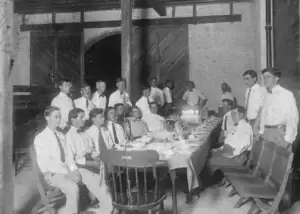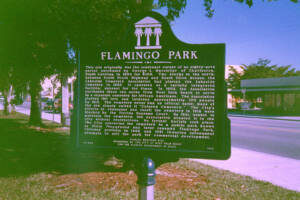Goods and Services: Public Utilities

Public services came one after another to the new town. In 1894 a water plant was built at Clear Lake, and the first public service organization in West Palm Beach was born, a volunteer fire department called the “Flagler Alerts.” The first equipment consisted of a hand-operated hose and reel. There were about 20 men in the original company, including the local sales agent for Standard Oil, an attorney, and a grocer-undertaker. They were alerted to fires by the large bell on Holy Trinity Episcopal Church at Evernia Street and Poinsettia (Dixie Highway). Two fires on January 2 and February 20, 1896, damaged or destroyed many business buildings, causing the city to establish a fire district where brick or stone exteriors were required.

The Flagler Alerts rented a frame house for a recreation hall and started fundraising for a firehouse and equipment. Henry Flagler made it possible to build the firehouse, and the city added horse-drawn equipment. In 1911 the first automated equipment, a hose truck and pumper, were donated, nine years after the City of West Palm Beach Fire Department replaced the Flagler Alerts volunteers.
Joseph Jefferson, an international stage actor, owned the first electric plant, West Palm Beach Electric Light, Ice, and Power Company. Electric service was available before 1900, at $1.50 per month for businesses and $.60 for residences (per light). A 1907 map of downtown West Palm Beach shows most buildings still used oil lamps. On January 10, 1904, however, the Palm Beach News had reported a historical occasion, as Jefferson turned over the electric plant to the town:
And the Lord said, ‘Let there be light, and there was light.’ With this remark concluding a number of bright sayings …Jefferson … stepped to a telephone in the Utopia Club room last night a few minutes after 9:00 and rang the bell. In a few seconds the whistle at the powerhouse began a long, loud and discordant note and then ran the musical scale—if whistles are musical—as a sign that the message had been received. Immediately the Bible injunction was fulfilled. The command came from the player, and bright electrics were turned on in the Utopia Club rooms; arc lights gleamed for the first time over the streets of West Palm Beach; and an interested crowd of spectators applauded and a stargazing public turned their attention from the firmament and came down to earth, so to speak, to watch the lights. That is really how it all occurred.
Palm Beach News, 1904
Joseph Jefferson was a familiar sight around town in his tricycle chair driven by secretary Carl Kettler. He was one of the few people besides Flagler willing to invest in the fledgling city. The Jefferson Block included a brick two-story building at Clematis and Olive avenues with six stores, Anthony’s store, and the Jefferson Hotel. The actor-developer lived at Datura and Narcissus streets, across from rental houses he owned, and later at one of the Breakers Cottages.
In 1899 a 25-year telephone franchise was granted to John B. Beach and George S. Adams. The West Palm Beach Telephone Company moved forward, owned by Beach, James R. Anthony, Jr., Marion E. Gruber, and Dr. J. E. Liddy. By 1907, service was connected to 18 phones. Mary Majewski Brewer recalled that her mother asked to be phone number one. Dr. Liddy had already promised it to George Currie, but the Majewskis were number two. Brewer later worked at the switchboard, located in Dr. Merrill’s Drug Store.
Gas Lights
An old colored man came around every evening at dusk, put up his little step ladder and lit the street lamps. A few years later, however, acetylene [gas] lights were erected on the street corners. They made such a brilliant light that the neighborhood children gathered under the light on our corner to play games until called to bed.
Dora Doster Utz
Cemeteries
When the cemetery site was chosen for a schoolhouse, the remains were relocated in April 1895 to the three-acre Lakeside Cemetery, presently the site of the Norton Gallery of Art. Henry Burkhardt attended the school that opened in 1895: “Of course in all cemeteries there are some bodies that they didn’t get up. And as kids going to school there, we … wouldn’t drink the water because it was pump water [from the ground].” Lakeside was also used as a social center for the pioneers, with a gazebo, an open-sided shelter, and many shade trees. Most of the graves were located on the north side, away from the center.
To the west of Lakeside Cemetery, in 1904 Wallace R. Moses laid out Flagler’s 17 acres of unprofitable pineapple fields as Woodlawn Cemetery, for use by whites only. Flagler deeded the land to the City of West Palm Beach, but he chose St. Augustine for his own resting place after West Palm Beach attempted to annex Palm Beach; he died in 1913.

Lakeside Cemetery Association welcomed burials of all races from 1895 until 1902, when it purchased two acres from the city, across County Road (Dixie Highway) a few blocks to the south. The “colored cemetery,” as it was known, was platted for 190 lots; by 1913 about 100 African Americans were buried there. Today it is a city park known as Flamingo Park, designated by the state as a Florida Heritage Site; a marker relates its history to visitors.

